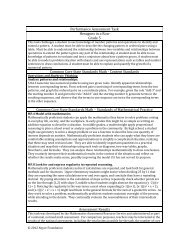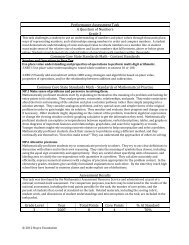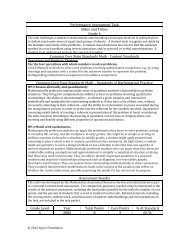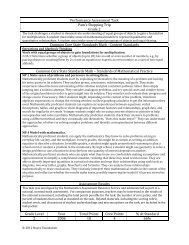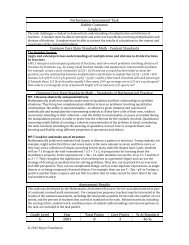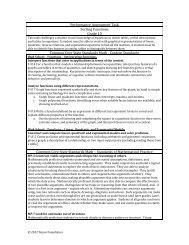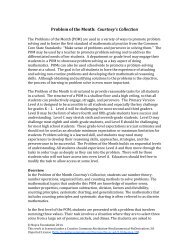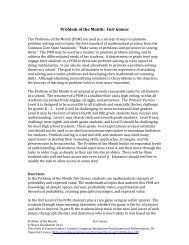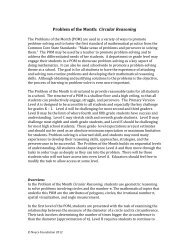Problem of the Month Measuring Up
Problem of the Month: Measuring Up - Inside Mathematics
Problem of the Month: Measuring Up - Inside Mathematics
You also want an ePaper? Increase the reach of your titles
YUMPU automatically turns print PDFs into web optimized ePapers that Google loves.
<strong>Problem</strong> <strong>of</strong> <strong>the</strong> <strong>Month</strong><br />
<strong>Measuring</strong> <strong>Up</strong><br />
Task Description – Level A<br />
This task challenges a student to read a story with a given recipe. The student is to determine how<br />
many carrots, onions, and chunks <strong>of</strong> meat are needed to make soup for various numbers <strong>of</strong> people.<br />
Common Core State Standards Math ‐ Content Standards<br />
Counting and Cardinality<br />
Know number names and <strong>the</strong> count sequence.<br />
K.CC.2 Count forward beginning from a given number within <strong>the</strong> known sequence (instead <strong>of</strong> having<br />
to begin at 1).<br />
Operations and Algebraic Thinking<br />
Understand addition as putting toge<strong>the</strong>r and adding to, and understand subtraction as taking<br />
apart and taking from.<br />
K.OA.1 Represent addition and subtraction with objects, fingers, mental images, drawings, sounds<br />
(e.g., claps), acting out situations, verbal explanations, expressions, or equations.<br />
Represent and solve problems involving addition and subtraction.<br />
2.OA.1 Use addition and subtraction within 100 to solve one‐ and two‐step word problems involving<br />
situations <strong>of</strong> adding to, taking from, putting toge<strong>the</strong>r, taking apart, and comparing, with unknowns in<br />
all positions, e.g., by using drawings and equations with a symbol for <strong>the</strong> unknown number to<br />
represent <strong>the</strong> problem.<br />
Number and Operations in Base Ten<br />
Use place value understanding and properties <strong>of</strong> operations to add and subtract.<br />
1.NBT.4 Add within 100, including adding a two‐digit number and a one‐digit number, and adding a<br />
two digit number and a multiple <strong>of</strong> 10, using concrete models or drawings and strategies based on<br />
place value, properties <strong>of</strong> operations, and/or <strong>the</strong> relationship between addition and subtraction;<br />
relate <strong>the</strong> strategy to a written method and explain <strong>the</strong> reasoning used. Understand that in adding<br />
two‐digit numbers, one adds tens and tens, ones and ones; and sometimes it is necessary to compose<br />
a ten.<br />
Common Core State Standards Math – Standards <strong>of</strong> Ma<strong>the</strong>matical Practice<br />
MP.2 Reason abstractly and quantitatively.<br />
Ma<strong>the</strong>matically pr<strong>of</strong>icient students make sense <strong>of</strong> quantities and <strong>the</strong>ir relationships in problem<br />
situations. They bring two complementary abilities to bear on problems involving quantitative<br />
relationships: <strong>the</strong> ability to decontextualize—to abstract a given situation and represent it<br />
symbolically and manipulate <strong>the</strong> representing symbols as if <strong>the</strong>y have a life <strong>of</strong> <strong>the</strong>ir own, without<br />
necessarily attending to <strong>the</strong>ir referents—and <strong>the</strong> ability to contextualize, to pause as needed during<br />
<strong>the</strong> manipulation process in order to probe into <strong>the</strong> referents for <strong>the</strong> symbols involved. Quantitative<br />
reasoning entails habits <strong>of</strong> creating a coherent representation <strong>of</strong> <strong>the</strong> problem at hand; considering<br />
<strong>the</strong> units involved; attending to <strong>the</strong> meaning <strong>of</strong> quantities, not just how to compute <strong>the</strong>m; and<br />
knowing and flexibly using different properties <strong>of</strong> operations and objects.<br />
MP.3 Construct viable arguments and critique <strong>the</strong> reasoning <strong>of</strong> o<strong>the</strong>rs.<br />
Ma<strong>the</strong>matically pr<strong>of</strong>icient students understand and use stated assumptions, definitions, and previously<br />
established results in constructing arguments. They make conjectures and build a logical progression <strong>of</strong><br />
statements to explore <strong>the</strong> truth <strong>of</strong> <strong>the</strong>ir conjectures. They are able to analyze situations by breaking <strong>the</strong>m into<br />
cases, and can recognize and use counterexamples. They justify <strong>the</strong>ir conclusions, communicate <strong>the</strong>m to o<strong>the</strong>rs,<br />
and respond to <strong>the</strong> arguments <strong>of</strong> o<strong>the</strong>rs. They reason inductively about data, making plausible arguments that<br />
take into account <strong>the</strong> context from which <strong>the</strong> data arose. Ma<strong>the</strong>matically pr<strong>of</strong>icient students are also able to<br />
compare <strong>the</strong> effectiveness <strong>of</strong> two plausible arguments, distinguish correct logic or reasoning from that which is<br />
flawed, and—if <strong>the</strong>re is a flaw in an argument—explain what it is. Elementary students can construct arguments<br />
using concrete referents such as objects, drawings, diagrams, and actions. Such arguments can make sense and<br />
be correct, even though <strong>the</strong>y are not generalized or made formal until later grades. Later, students learn to<br />
determine domains to which an argument applies. Students at all grades can listen or read <strong>the</strong> arguments <strong>of</strong><br />
o<strong>the</strong>rs, decide whe<strong>the</strong>r <strong>the</strong>y make sense, and ask useful questions to clarify or improve <strong>the</strong> arguments.<br />
CCSSM Alignment: <strong>Problem</strong> <strong>of</strong> <strong>the</strong> <strong>Month</strong> <strong>Measuring</strong> <strong>Up</strong> Page 3<br />
© Noyce Foundation 2014.<br />
This work is licensed under a Creative Commons Attribution-NonCommercial-NoDerivatives 3.0 Unported<br />
License (http://creativecommons.org/licenses/by-nc-nd/3.0/deed.en_US).



